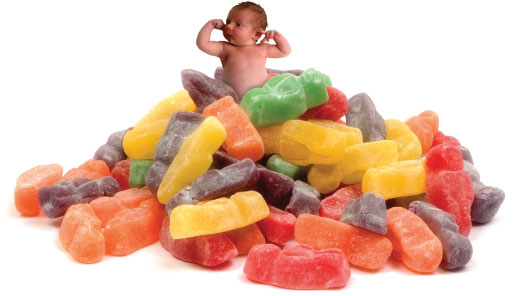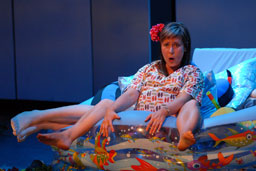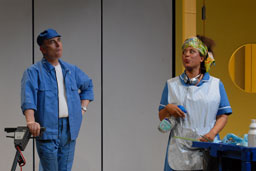THE FIRST EMAIL
It’s funny now to think that Anna and I first met as the crowds
gathererd for a previous Tete a Tete show back in February 2002. This was my
second operatic excursion, Has it Happened yet? and featured three very
old ladies wheeled out to watch a solar eclipse. A mutual friend had brought
Anna along and we hit it off straight away. I knew she was a playwright, but at
that stage the idea of developing a full, evening-long opera seemed a distant
dream. HIHY and Seven Tons of Dung,- my two previous shows for Tete a
Tete - were both around 10 mins long, and whilst the idea of a longer show
haunted me, it seemed to be so lavish and exciting an idea, as to be something I
would have to put on hold until a time when things were going impossibly well.
Anna and I kept in touch and even started working together on our
own writers website writewords.org.uk (together with mutual friend Richard), but
it was over a year later, in March 2003, before Anna in the course of her
research for the website had come across the Genesis Opera Project’s call for
entries. Genesis is an organisation looking to help develop new operatic talent
and the selected entrants would apparently get the opportunity to write and hear
a full operatic work.. Anna dropped me a casual email with the details asking
simply :
Of interest to you-- or you/me?
Anna
And
that was the beginning of Push!
***
THE BIRTH
OF AN IDEA
So where to start? An obvious first thing to do was
to swap scores and scripts. I gave her the blaring, bell-ringing intro to Dung,
and Anna gave me several scripts, including one called “Goodbye Stranger”, which
to my delight instantly grabbed me. It had sharp and witty dialogues, which
hinted at profound truths without being didactic or preacherly; but perhaps most
striking to me was the structure – it was a series of about 30 short scenes, all
featuring couples in bed – effectively a series of one-night-stands.
This structure instantly gave us a mutual starting point. What I had
enjoyed about the previous Tete a Tete shows was their sketch-like structure
which allowed for a huge range of expression in a very audience-friendly way.
Put simply, if you didn’t like the current 10-minute segment, something very
different would be along shortly.
So the idea for an opera based on
a series of short scenes with a common subject or setting, was born. I knew
Anna’s idea of a series of one-night-stands was both brilliant and unrepeatable
– and we struggled to find an equally compelling subject.
I must admit
the idea of a series of births popped into my head quite randomly, but the more
we mulled it over, the more it seemed to fit the bill perfectly. As the most
dramatic moment in most people’s lives, it seemed extraordinarily operatic and
indeed bizarre that there had been no previous birth operas (to our knowledge) –
and of course in a way it is the logical outcome of Anna’s previous
one-night-stands script!
MEETING THE PANEL.
It’s easy to oversimplify things in retrospect – everything now
seems to be a smooth line leading to today – but I think when we finally met the
Genesis Opera Project Panel in late Summer 2003 we were still pretty vague about
where we were going. I think the one thing the panel did pick up on was how Anna
and I had an intuitive understanding of each other - that we were confident that
whatever it was, we could pull it together between us. In the operatic world,
finding the right match of composer and librettist seems to be one of the
biggest challenges and once that’s right, much of the problem is solved.
I do remember we were imagining babies and baby voices quite a bit –
far more than we ended up with, and I remember David Poutney asking me how these
babies would be presented – perhaps as marionettes? “Yes, more like marionettes”
I answered – I didn’t yet really have a clue.
FORGING THE
LIBRETTO
So the panel gave us the go ahead. Anna was to produce
the entire libretto and I was to set 20 mins or so to music, for a workshop
presentation the following Spring. For me the best thing was there was an
unrestricted choice of 13 instruments and 8 singers.
There followed
probably the most tense month of the project as Anna produced some initial
scenes and we negotiated the tricky foothills of collaboration. This is the
stage that projects sometimes fall apart, and it requires diplomacy, tact and
above all patience on both sides. Anna was quite new to Opera and I think she
initially may have felt intimidated by the sense of the ‘style in which one
ought to write for the Opera’- I think she was imagining lots of red plush and
horn-helmeted Brunhildas everywhere. I told her to just write the same way she
writes for the stage, and I think that was our first breakthrough.
Anna then produced an early draft of what is now the first scene
Nimmy. It was a gritty drama featuring a young girl and although I loved the
writing, I still felt it hadn’t quite clicked into place yet as an operatic
libretto. I sat down with my wife Gosia one day and talked it through, a bit
frustrated and not sure what to do next. Gosia suggested it needed to be more
fantasitic and colourful. There was some mention of football in the Nimmy scene
– “turn it into a football match, get the crowd on stage” she suggested.
I knew this was right, and once I’d communicated this sense of
fantasy to Anna the penny dropped. Within a few days she produced Cara, with her
three distorted lovers and a birthing pool which turns into an underwater world
full of shipwrecks and skeletons; a re-drafted footballing Nimmy; and most
spectacularly, Mary, an IVF woman who tells stories to the 5 restless babies in
her womb, before some buidlers with chainsaws come in and erect screens around
her like a building site. Wow!
But she didn’t stop there. One of my
pitches to the Genesis panel had been to continue what we had attempted in Has
it Happened Yet? in terms of setting up a witty and light-hearted framework,
which then surprisingly became intense and moving. I never wanted to write a
straight-forward comedy, and one of the shows Anna and I had both loved – Shock
Headed Peter – we both equally felt had lacked an emotional or human core. It
was great fun, but so what? We wanted to do something bigger than that.
And on this side of the equation, Anna came up with an incredibly
dark scene called “Maddy”, a bleak and desperate depiction of a prisoner chained
to her maternity bed; and then the indescribable beauty and heart-ache of
“Angela”.
We were now well on our way to a complete libretto, but
what we still didn’t quite have was the overall sense of how these scenes would
gell into a coherent and meaningful evening, and that would still take some time
to find…
A TRIP TO ALDEBURGH
We were invited to
Aldeburgh in late Autumn 2003 for a chance to hear some actors read through what
we had of the libretto. I found the read-throughs very stimulating, as they
brought out hidden dramas in the text which I might not otherwise have
discovered. One good example of this is that builders entrance I mentioned
earlier in “Mary”. Director Will Kerley brought a marvellously manic intensity
to the read-throughs, and during Mary’s speech, after the builders have come in,
he himself added a rumbling, spluttering background sound effect of the distant
chainsaws as Mary spoke. It was exactly the right feeling - Will’s role
translated into a deep rumble on the double bass in the full score, but more
than that the atmoshpere of a rather placid, spaced-out Mary sitting atop a
furnace of mechanical activity was what really inspired the music at that point
and I’m very grateful to Will and the actors for finding that.
WORKSHOP AT SADLERS WELLS
At the orchestral
workshop at Sadlers Wells in Spring 2004 I got to hear 20 mins of my music,
setting Cara and Nimmy, as well as some now-deleted linking scenes we attempted
with a character called Soozy who was pregnant but not yet in labour.
After the performance there was an open discussion, and one lady in
the audience asked why would anyone be interested in an opera about giving
birth, what made us choose such a subject? To my surprise I found the answer I
had rehearsed in my head about this didn’t sound convincing when I said it out
loud, so I knew we still had a bit more work to do in understanding what this
opera was really about.
I agonised over the summer of 2004 about
this. We already had quite a lot of material but we just hadn’t found a way of
tieing it all together and giving it meaning. I looked at various ways in which
the question of tieing together a fragmented structure had been handled
elsewhere. Anna and I particularly enjoyed the film Magnolia, whose series of
fragmented scenes get drawn together by a bizarre storm of raining frogs which
stops everyone dead in their tracks and in ways I can’t fathom provides a
satisfying sense of conclusion. Patrick Dickie at Almeida also suggested the
play Angels in America, which I loved; but on reflection both of these seemed
more intricate objects than our five or six big scenes.
ENTER THE
TETE’s
In late summer 2004 I awoke to the realisation that what
I had hoped to create all along was a Tete a Tete show. I wasn’t yet imaginging
Tete a Tete would actually produce it, but in my mind I could see the show
needed to have that vivid, life-loving theatricality that Tete a Tete shows
exude. This is how the idea of cleaners in the maternity ward arrived – it
seemed a way of keeping the wit and theatre in the piece and preventing it from
becoming too ‘worthy’.
Anna wrote some perfect little cleaner
sketches, including a first one with no dialogue at all - just the off-stage
screams from the labouring mothers. It felt right.
But we still
hadn’t sorted the final scene, and even the order of the scenes seemed to
fluctuate.
Enter Bill Bankes Jones, director of Tete a Tete and my
librettist on both the previous mini-operas. Bill had come along to the Sadlers
Wells performace and had expressed an interest in directing Push! and possibly
even getting Tete a Tete involved to producing the final show.
Out
of his repository of theatrical knowledge Bill dredged a little-known musical
from the 80s about four women at Greenham Common , one of whom gives birth at
the end of the show. The script reads as a straight-forward, almost prosaic
description of the progress of the birth, and culminates, hilariously, in a
jolly cabaret song full of crescendoing “oooos” There was something about the
simplicity and directness of that birthing scene that really appealed to me. I
realised our final scene should present birth ‘as it is’, without the fantasy, a
normal woman giving birth in a normal way, in all its normal extraordinariness.
Our new cleaner seemed the inescapable candidate for the role.
One
final twist Bill helped with was in the placing of the Angela scene. The scene
is so traumatic that it seemed very hard to find a place for. Bill suggested it
had to be the penultimate scene, so that the highlight and joy of the final
birth scene follows directly on from the woman who most wants a baby but can’t
have it. It’s a brilliant dramatic payoff and heightens the reward of the final
scene.
FINISHING THINGS OFF
By now I felt I
had finally found the real answer to the question that woman from the Sadlers
Wells audience had asked. Why pick this subject, why should anyone come and see
it? I was clear now that this piece was above all else a celebration of the
sheer power and life-force bound up in every labouring mother. Our rather
ordinary Cleaner was the heroine, and through her all our other mothers, with
all the varying dramas of motherhood, life and death that they represent. It was
in short, an unflinching celebration of motherhood and birth.







